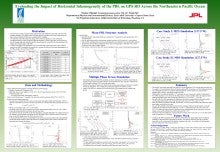Horizontal Inhomogeneity of the Planetary Boundary Layer and its Impact on GPS Radio Occultation Retrieval over the Northeastern Pacific Ocean
Thomas
Winning
Jet Propulsion Laboratory, Texas A&M University-Corpus Christi
Poster
GPS radio occultation (RO) retrieval generally assumes a local, spherically symmetric atmosphere. Horizontal inhomogeneity leads to retrieval errors in the RO bending angle and refractivity profiles and in particular affects the determination of the height and vertical structure of the planetary boundary layer (PBL). To assess the effects of horizontal inhomogeneity, this study focuses on the Northeastern Pacific Ocean where the Marine ARM GPCI Investigation of Clouds (MAGIC) field campaign collected over 500 radiosonde profiles from October 2012–September 2013 between Los Angeles, CA and Honolulu, HI. The radiosonde soundings are binned into 5° longitude intervals along the ship track to generate mean profiles of temperature (T), pressure (P), specific humidity (q) and refractivity (N). Along the ship track, the PBL height increases from less than 1 km off the coast of California to near 2 km in the Hawaiian Islands region. The mean radiosonde profiles are used to represent the realistic, horizontally inhomogeneous PBL. A multiple-phase-screen (MPS) simulation of the GPS signal propagation through the mean atmosphere is carried out along the ship track. Refractivity profiles are then retrieved from the simulation data using standard RO retrieval technique. Comparison between the 2-D refractivity fields and the retrieved profiles allows us to assess the errors in the retrieved profiles due to horizontal inhomogeneity. In addition, it provides an estimate of the along-track horizontal resolution of the retrieved refractivity.

Abstract file